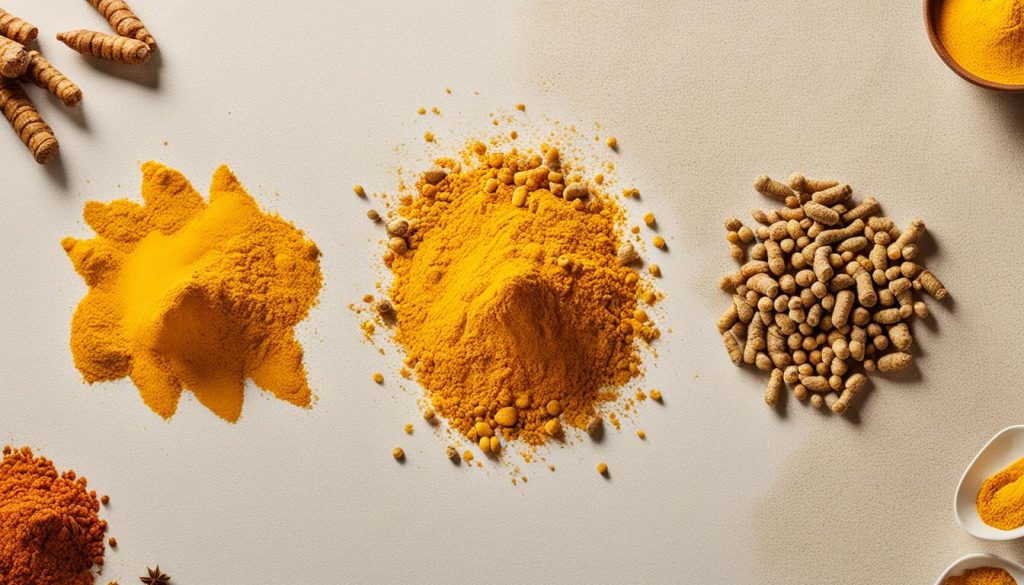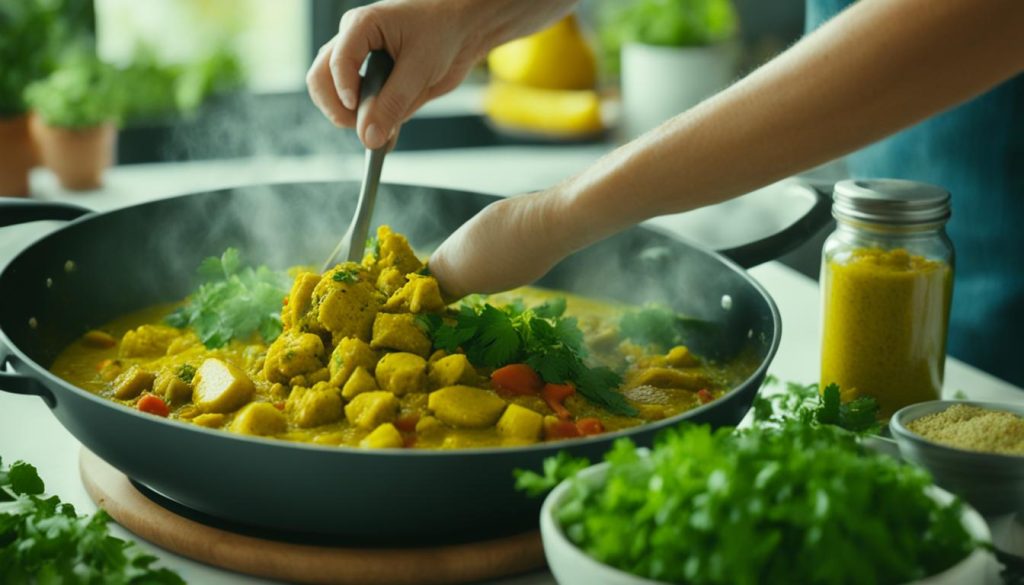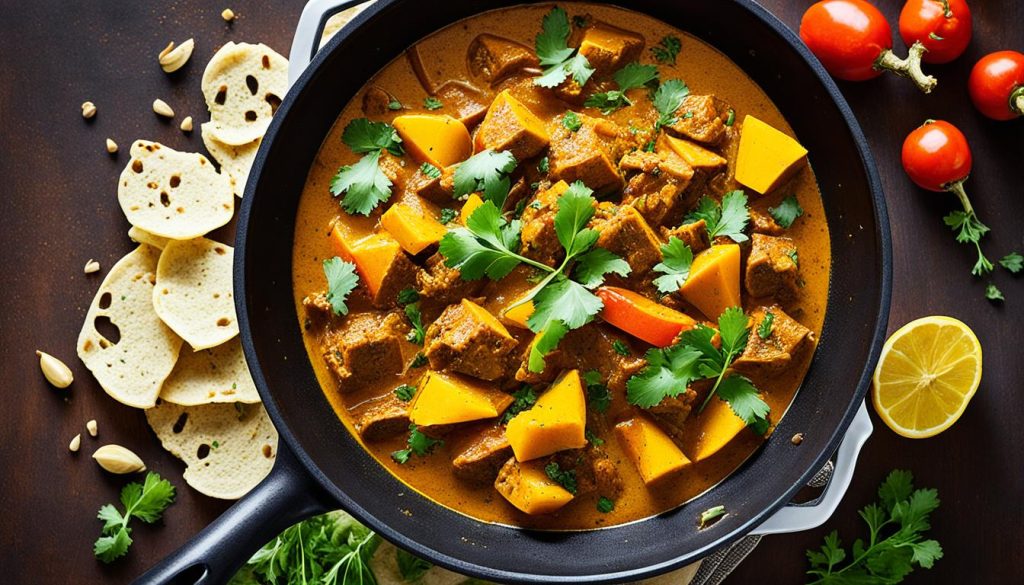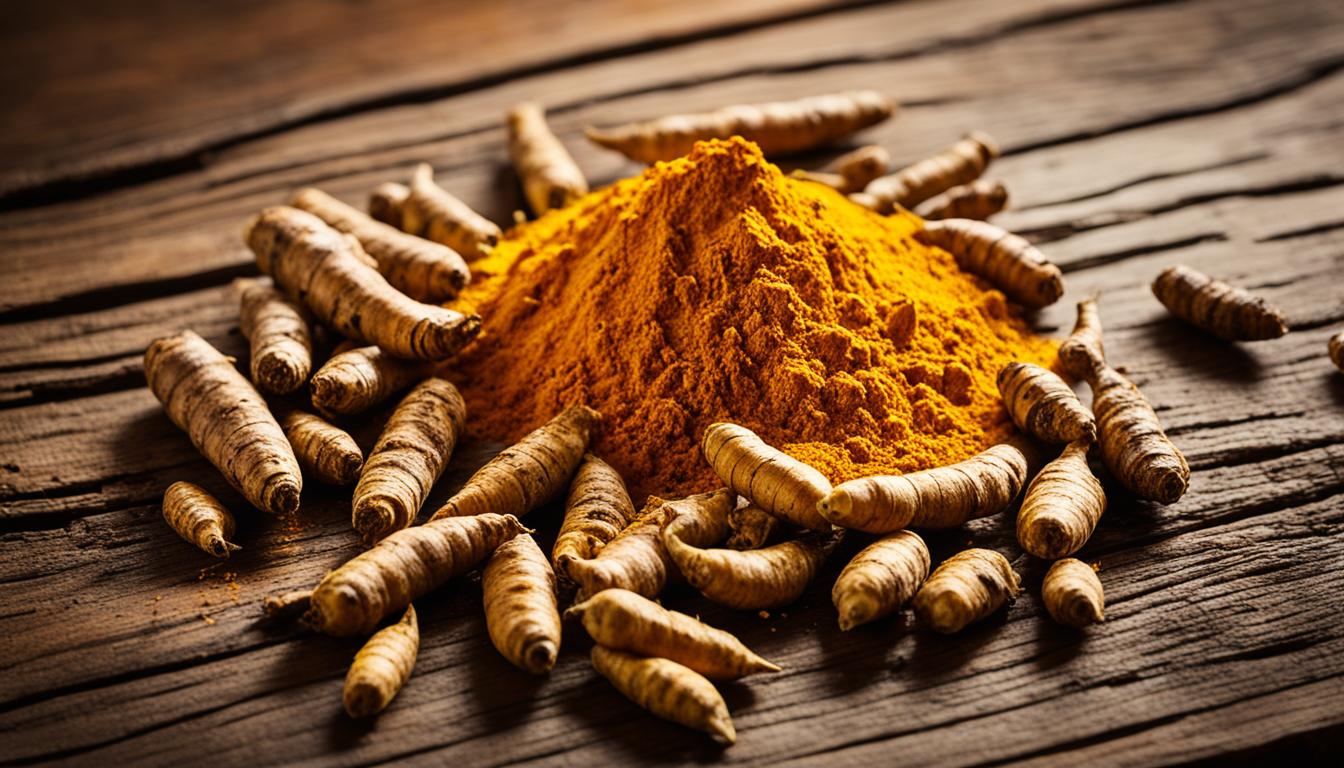I love cooking and exploring spices, especially turmeric. This spice is golden-orange and packed with health benefits. It’s related to ginger and has been used for centuries in Asia and traditional medicine.
Turmeric contains curcumin, a powerful antioxidant and anti-inflammatory. It’s great for adding nutrition to your meals or exploring ancient healing traditions. Turmeric is a top choice for health and cooking.
This article will cover turmeric’s history, health benefits, and how to use it in cooking. You’ll learn about its compounds and how to add it to your meals. From curries to tea, turmeric offers many ways to improve your health.
Join me on this journey into the world of turmeric. Let’s discover how this spice can make our meals and lives better!
What is Turmeric?
Turmeric comes from Southeast Asia’s lush lands. It has a vibrant orange flesh that is often dried and ground. This makes the golden powder we call turmeric. For over 4,000 years, it has been key in Indian cooking and is valued in Hindu and Ayurvedic traditions.
The Golden Spice from Southeast Asia
In the Middle Ages, turmeric came to Europe and was called “Indian saffron”. It was cheaper than the real saffron. Later, it went to the Caribbean with Indian workers. Now, it’s a main ingredient in many dishes there.
Turmeric’s History and Origins
The turmeric plant started in Southeast Asia’s tropical areas. India is a big producer and user of this spice. It’s a must-have in South Asian cooking, adding flavor to many dishes.
Turmeric root is also known for its health benefits. Its curcumin fights inflammation and is full of antioxidants. The golden spice is loved worldwide for its taste and health perks.
The Powerful Compound: Curcumin
Curcumin is the main part of turmeric. It has amazing antioxidant and anti-inflammatory properties. This substance makes turmeric bright yellow and helps with its health benefits.
Antioxidant and Anti-Inflammatory Properties
Curcumin fights free radicals and protects cells from harm. It can also control inflammation in the body. This makes it a great natural way to fight chronic inflammation.
Eating foods like turmeric can help prevent many diseases. These include some cancers and heart disease. Curcumin can also boost brain function, ease pain, help control blood sugar, and lower heart disease risk.

“Curcumin has many biological activities, and like other colorful plant-based foods, turmeric is rich in phytonutrients that may protect the body by neutralizing free radicals and shielding the cells from damage.”
Health Benefits of Turmeric
Turmeric is a superfood with a long history in traditional medicine. It has many health benefits that make it great for wellness. Its main compound, curcumin, is studied for its anti-inflammatory, antioxidant, and antimicrobial properties.
People with chronic inflammation, like arthritis or colitis, might find relief with turmeric. Curcumin helps reduce inflammation. This can ease pain and swelling, offering a natural alternative to some medicines.
Turmeric also helps with brain function, blood sugar levels, and may lower heart disease and cancer risk. While more research is needed, turmeric’s benefits are clear. It’s a key part of a wellness routine.
“Turmeric is a remarkable spice with a long history of medicinal use. Its active compound, curcumin, has been shown to possess a wide range of therapeutic benefits, from reducing inflammation to potentially protecting against cognitive decline.”
Adding turmeric to your diet is easy and tasty. It’s a great way to support your health. You can use it in curries, stews, teas, or supplements to enjoy its benefits.
Cooking with Turmeric
Turmeric is more than just a spice that makes food look bright. It’s also a key ingredient that can make many dishes better. Whether you use ground turmeric powder or fresh turmeric root, it can make your food taste great.
Using Ground Turmeric Powder
A little ground turmeric powder can go a long way. I usually add half a teaspoon to things like bean dishes, rice, and soups. It also works well in sauces, marinades, and pickling brines.
But turmeric isn’t just for savory dishes. It can also make breakfast foods, mac and cheese, cakes, and desserts taste better. Its warm, earthy flavor adds color and depth to these foods.
Fresh Turmeric Root: Grating and Storing
If you can get your hands on fresh turmeric root, grate it like you would ginger. This brings out its unique taste. Just remember to wear kitchen gloves when handling it because it can stain.
Use 1 tablespoon of grated fresh turmeric for every 1 teaspoon of dried turmeric. This way, you can get the best flavor.
To keep turmeric fresh, store ground powder in a cool, dark place. Keep fresh turmeric root in the fridge or freezer.

“Turmeric is not only a vibrant spice, but it also offers a wealth of culinary possibilities.”
Turmeric Tea: A Healthy Indulgence
Turmeric is more than just a spice for cooking. It’s a treasure for health. Enjoy its benefits with a warm cup of turmeric tea.
To make this tea, use fresh turmeric root or ground turmeric powder. Mix 2 tablespoons of turmeric root or 2 teaspoons of powder with 1-2 cups of water. Boil it, then simmer for 5 minutes. Strain and drink it warm or cold, with lemon or honey for taste.
Turmeric root, like ginger, makes a soothing tea. It has curcumin, which fights inflammation and is full of antioxidants. This makes turmeric tea a great choice for health.
Turmeric tea is a delightful way to incorporate the benefits of this golden spice into your daily routine.
Choose fresh turmeric root or ground powder for your tea. Drinking turmeric tea is comforting and healthy. Try it and enjoy its unique taste and health perks.
Turmeric in Indian and Middle Eastern Cuisines
Turmeric is a key spice in Indian and Middle Eastern cooking. It adds a unique taste to many dishes. This spice is found in curries, stews, and spice mixes.
Curries, Stews, and Spice Blends
In India, turmeric is a must-have in curries like Chicken Tikka Masala. It gives curries a warm color and deep flavor. In the Middle East, it’s in spice mixes like Za’atar and Advieh.
Turmeric is also great in stews and braises. It’s in dishes like Indian Lamb Rogan Josh and Egyptian Koshari. This spice colors and flavors food in a special way.
| Turmeric in Indian Cuisine | Turmeric in Middle Eastern Cuisine |
|---|---|
|
|
“Turmeric is the golden thread that weaves through the tapestry of Indian and Middle Eastern cuisine, adding depth, color, and an unmistakable flavor profile to some of the world’s most beloved dishes.”

Incorporating Turmeric into Your Diet
Turmeric is more than just a spice for curries and stews. It can be added to many recipes, from breakfast to baked goods. Adding turmeric to your meals can bring health benefits.
Recipes Featuring the Golden Spice
Turmeric’s flavor is earthy and slightly peppery. Try it in a Turmeric Mango Smoothie or Shakshuka, with eggs in a turmeric sauce. For lunch and dinner, use it in soups like Golden Turkey Noodle Soup or stews.
Baked goods are great for turmeric too. Add it to breads, muffins, and cookies for a unique taste. There are many ways to use turmeric in recipes.
Adding turmeric to your meals gives you anti-inflammatory and antioxidant benefits. Try new recipes with turmeric in breakfast, soups, and baked goods.
Turmeric Supplements: Pros and Cons
Turmeric is a golden spice that many people are now interested in for its health benefits. Eating turmeric in foods or teas is a safe way to get its benefits. But, taking turmeric supplements needs more care.
Turmeric supplements have a lot more curcumin than eating turmeric in food. This can lead to more side effects, especially for people with health issues or on certain medicines.
For example, turmeric supplements might not work well with painkillers, cancer drugs, or blood thinners. They could make these drugs less effective or cause bad reactions. Also, the body may not easily absorb curcumin from supplements.
| Pros of Turmeric Supplements | Cons of Turmeric Supplements |
|---|---|
|
|
For most, eating turmeric in foods like curries or teas is safer and more effective. If you’re thinking about turmeric supplements, talk to a healthcare professional first. They can help make sure they’re right for you.

“While turmeric supplements may seem like a quick fix, the potential risks often outweigh the benefits for the average person. Focusing on incorporating turmeric into your meals is a safer, more sustainable approach.”
Precautions and Side Effects
Turmeric is usually safe when eaten in food or as tea. But, taking a lot of it from supplements can be risky. Knowing the possible side effects and interactions with turmeric is key to using it safely and effectively.
Turmeric Drug Interactions
Taking turmeric supplements might affect how some medicines work. This can make them less effective or increase side effects. These include painkillers, chemotherapy drugs, and blood thinners. Always talk to a healthcare professional before taking turmeric supplements, especially if you’re on other medicines.
Turmeric Allergies and Side Effects
- People allergic to turmeric might get rashes, hives, or stomach pain from it.
- Taking turmeric supplements can raise the chance of getting kidney stones, especially if you have a family history of them.
- High doses of turmeric supplements can sometimes cause stomach issues like nausea, diarrhea, or heartburn.
So, it’s usually safer to get turmeric from food rather than supplements. Adding turmeric to your meals, like in curries, stews, or drinks, can give you its health benefits without the risks of too much supplementation.
“Always consult with a healthcare professional before starting any supplement regimen, including turmeric, to ensure it’s safe and appropriate for your individual needs.”
The Golden Spice with Powerful Health Benefits
I love food and health, so I’ve learned a lot about turmeric. This spice is known for its bright color and many health benefits. It has a compound called curcumin that fights inflammation and acts as an antioxidant.
This can help with arthritis, joint pain, allergies, and some cancers. I add turmeric to my food often. Whether it’s in a curry, tea, or smoothie, it’s a tasty way to stay healthy.
Turmeric is easy to add to many dishes, making it a great choice for a healthy diet. While supplements have more curcumin, I prefer getting it from food. It’s safer and more effective.
Turmeric has a long history in Southeast Asian cooking and is now popular in health circles. I suggest trying different ways to use it in your cooking. It’s a spice that’s both healthy and tasty, making it a must-have in any kitchen.

